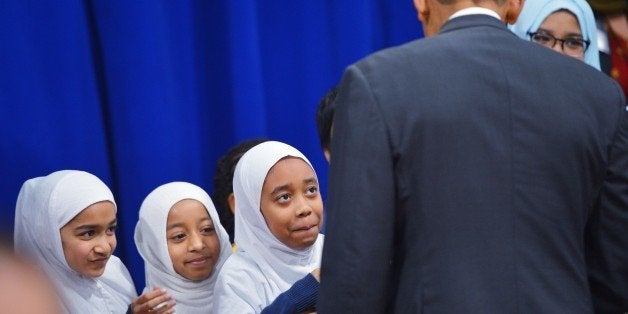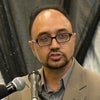
"Muslims are part and parcel of the American and European scene."
"Therefore, any talk of Islam and the West must be complemented by our recognition of Islam in the West."
If Islam is currently in America, America, in dealing with Islam, should learn about its own unique experience and the challenges Muslims face. At least two features distinguish American Muslims from their European counterparts. Traditionally, most Muslim immigrants to the USA were professionals while in Europe most were from the working class. Perhaps, most importantly, African-Americans created a new image of Islam that was absent in Europe. Let us focus on this latter point.
(1) Around two-thirds (60%) of America's Muslims are from immigrant families; the others are converts, primarily African-American.
African-American Islam emerged in the early twentieth century when many Blacks converted to Islam, what they conceived as a return to their authentic spiritual and cultural roots.
This turn was a selective mix of Islamic symbols and Black Nationalism. American Muslims still must deal with this mix to develop a more constructive Islam. The Nation of Islam represents this movement which consisted of both very negative and very positive aspects and took a long time to define itself in a peaceful and constructive way.
It started with an egalitarian message for social justice. First, Wallace D. Fard Muhammad (disappeared in 1934), initiated a black liberation movement, in the ghetto of Detroit. Although he was recognized as the Islamic Messiah (the Great Mahdi, or savior) he used Islam as a weapon for his ideological agenda, black nationalism, and against white people and Christianity.
His successor Elijah Muhammad (1897-1975) corrupted Islam, identified Fard as Allah, which meant God was a black man. In turn, he made himself as the messenger of God. However, he gave to the marginalized poor with lower self-esteemed blacks a sense of identity, community, self-improvement, and empowerment to survive in a discriminating society.
Still negative points remained, among them: black separatism and supremacy, excommunicating dissidents including his two sons. The Nation of Islam did not practice the major Islamic rituals, like many lay Talibans in Afghanistan who do not know about daily prayers!
A major transition occurred in the Nation of Islam with Malcolm X (1925-65) and Wallace D. Muhammad (1933-2008), the son of Elijah Muhammad. Malcolm X brought the movements into line with the civil right movement, the Vietnam War Protest, and solidarity with liberation struggles in colonial Africa. Wallace D. Muhammad brought it closer to mainstream Islamic doctrines and practices and advanced the role of women in ministry.
Passing many modifications and overcoming so many errors, African-Americans learned to adapt the new image of Islam and present their Islamic identity in helping to solve concrete problems like racism, poverty, crime, violence, and drugs.
(2) Other American Muslims can learn much from this movement in adjusting their faith with American life, opportunities and challenges. As American Muslims' stories vary from those of Europeans, so do they differ from those in Africa or Asia. Not only schedules, schooling, and vacations are different, but also parties, discipline, and parent-child relationships. So they must go further, in producing an American Islam.
This calls for a harmony of Islamic and American values. Islamic law; Shariah, consists in a marriage between actual life and God's commands. This is why it is believed that a rural Mufti's (faith direction) reflects rural conditions and thus but it changed and adopted for the city-dweller. Thus, it is completely a faithful demand that American's faith direction have to reflect realities here.
American Islam does not mean necessarily observing Juma (community) prayer on Sunday instead of Friday-thus imitating US values; but it means developing institutions that are indigenously rooted and respond, not merely react, to realities; this must be adapted Islam to an American context.
If the Quran encourages Muslims to
"Listen to all words and follow the best ones,"
(the Quran, 39:18) it suggests at least that Muslims should listen to non-Muslim Americans and learn from them. If the Quran clearly calls for "Common Word" among Muslims, Christians, and Jews (3:64), it supports dialogue among different parts of American faithful culture. If the Prophet said,
"Loving the hometown is a part of faith"
this is a duty of American Imams to teach American Muslims to love their country. If God describes a hometown's safety and good economy as Divinity's bounty to a nation (106:4) it is the responsibility of American Imams to teach their students thanksgiving for their good economy and security.
(3) Non-Muslim Americans too can learn from this narrative on the Nation of Islam. The movement had reactionary elements. Of the six million Muslims in America, more than the population of Libya, Kuwait, or Qatar, many serve as health-care professionals, managers, businessmen, professors and students, engineers, etc.
In this new replacement of a predominantly Judeo-Christian mindset with a common Judeo-Christian-Islamic tradition, many things have to be done. Among them, two are most significant: definition of American Islam by Muslims and treating Muslims as a part of "Self" by non-Muslims.
When Islam is seen as a "foreign religion" and Muslims as foreigners, it only alienates. If the transition from Judeo-Christian to Judeo-Christian-Islam is recognized it helps both Non-Muslims to enrich their culture and Muslims to learn from other faiths and their experiences in peaceful interpretations of the faith as well as modern values like humanism and rationalism, human rights, women's rights, etc.
American and Islamic identities can be understood as stiff and narrow things which contradict each other and fuel extremism. Or, they can be understood as flexible and broad realities in which to shape American life. This would help to realize the American dream, and widen human horizons - a true expectation of American civilization.
